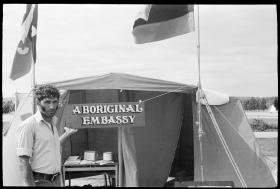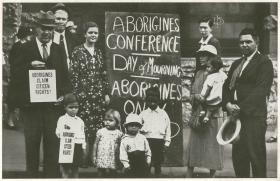Actions for Aboriginal rights
Key inquiry question #1
Why and how did Australia become a nation?
Key inquiry question #2
How did Australian society change throughout the twentieth century?
Key inquiry question #3
What contribution have significant individuals and groups made to the development of Australian society?
Content Summary
Experiences of Australian democracy and citizenship, including the status and rights of Aboriginal people and/or Torres Strait Islanders, migrants, women, and children. (ACHHK114)
Background Notes for teachers
Most social change is made up of small reforms that might seem insignificant at the time, but taken as a whole, can result in significant changes in society.
If we look at the status of Indigenous rights since the 1930s we can note certain moments that altered perceptions and pushed particular boundaries. Individually these moments were hard fought and involved sacrifices by the people involved that may appear out of proportion to the gain. However each step allowed the next to be taken, each achievement was a platform for the next to be built on.
Here we have four sources that stretch across eighty years: 1938, 1967, 1972 and 2008.
26 January 1938 was the 150th anniversary of the arrival of the First Fleet. On this day, while the majority of Australia celebrated the event, Aboriginal activists and other protesters gathered for a 'Day of Mourning' protest to bring attention to their plight and demand full citizens' rights.
Following reforms encouraged by the Day of Mourning, on 27 May 1967 a referenfum approved the inclusion of Indigenous people in the national census and gave the Federal government power to legislate for Indigenous people, and thus overrule discriminatory state laws.
In 1971 the McMahon Liberal Government was planning to implement a land lease system which excluded Indigenous rights to mineral and forestry resources. Because the government had rejected a proposal for Aboriginal land rights, on 26 January 1972 Indigenous activists set up the Aboriginal Tent Embassy on the grounds of what is now the old Federal Parliament building in Canberra. This pushed Aboriginal affairs into the spotlight and the new Whitlam government established a Royal Commission into land rights and overruled certain discriminatory state laws in Queensland.
The fourth source depicts the televised speech in Federal Parliament by Prime Minister Kevin Rudd on 13 February 2008 when he tabled a motion in parliament, apologising for the 'laws and policies... that have inflicted profound grief, suffering and loss' to Aboriginal and Torres Strait Islander peoples. The apology was especially intented for those affected by the official government policies allowing removal of children from Aboriginal families. These displaced children became known as the Stolen Generations.
The activities are designed to introduce students to images and written sources as historical records of people, places and events in the past. Students examine the images and written sources from the State Library of NSW to investigate key events in the move by Indigenous Australians for political rights.
Student Activities
Aboriginal Rights
Students examine sources from four different historical events that led to change for Aboriginal peoples' rights.

History from an Aboriginal perspective
Students assume the perspective of an Aboriginal person and write a letter to the editor concerning the sources from activity 1

Resources
Additional resources - Day of Mourning
‘Brief history of the “Day of Mourning and Protest” event, by G. Mesnage, Contested Spaces Contested Times, June 1998
1967 Referendum
Aboriginal Tent Embassy
‘A history of the Aboriginal Tent Embassy’, by Tim Leslie, ABC News
Apology to Australia’s Indigenous People (the ‘Stolen Generations’)
Apology to Australia’s Indigenous Peoples, February 13 2008
‘Bringing them home: The ‘Stolen Children’ report (1997), by the Australian Human Rights Commission
NSW Syllabus for the Australian Curriculum History K - 10
A student:
- HT3-3 identifies change and continuity and describes the causes and effects of change on Australian society
- HT3-5 applies a variety of skills of historical inquiry and communication
Students:
Comprehension: Chronology, terms and concepts
- sequence historical people and events. (ACHHS098, ACHHS117)
Use of sources:
- locate information related to inquiry questions in a range of sources. (ACHHS102, ACHHS121)
- compare information from a range of sources. (ACHHS103, ACHHS122)
Perspectives and interpretations
- identify points of view in the past and present (ACHHS104, ACHHS123)
Research
- identify and locate a range of relevant sources to support an historical inquiry (ACHHS101, ACHHS120)
Explanation and communication
- develop texts, particularly narratives and descriptions, which incorporate source material (ACHHS105, ACHHS124)
- use a range of communication forms (oral, graphic, written) and digital technologies (ACHHS106, ACHHS125)
Cause and effect
- events, decisions or developments in the past that produce later actions, results or effects
Perspectives:
- people from the past will have different views and experiences
Learning across the curriculum
- Aboriginal and Torres Strait Islander histories and cultures
- Intercultural understanding